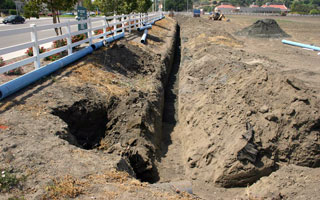The water footprint of an individual, business or nation is defined as the total volume of freshwater that is used to produce the foods and services consumed by the individual, business or nation. A water footprint is generally expressed in terms of the volume of water use per year.

Since not all goods consumed in one particular country are produced in that country, the water footprint consists of two parts: use of domestic water resources and use of water outside the borders of the country. The water footprint includes both the water withdrawn from surface and groundwater and the use of soil water (in agricultural production).
Virtual water is the water ’embedded’ in commodities. Producing goods and services requires water; the water used to produce agricultural or industrial products is called the virtual water of the product.
The global volume of virtual water flows related to the international trade in commodities is 1,600 Km3/yr. About 80% of these virtual water flows relate to the trade in agricultural products, while the remainder is related to industrial product trade.
The production of 1 kilogram of:
- rice requires 3,000 litres of water
- maize requires 900 litres of water
- wheat requires 1,350 litres of water
- beef requires 16,000 litres of water.
140 litres of water are needed to produce 1 cup of coffee while the production of 1 litre of milk requires 1,000 litres of water.
Globally, water is saved if agricultural products are traded from regions with high water productivity to those with low water productivity. At present, if importing countries produced all imported agricultural products domestically, they would require 1,600 Km3 of water per year; however, the products are being produced with only 1.200 Km3/yr in the exporting countries, saving global water resources by roughly 400 billion m3/yr.
The per capita consumption of virtual water contained in our diets varies according to the type of diet, from 1 m3/day for a survival diet, to 2.6 m3/day for a vegetarian diet and over 5 m3 for a United States style meat based diet.
Only about 7% of the Chinese water footprint of 700 m3 per capita per year (m3/cap/yr) falls outside of China, whereas 65% of Japan’s total water footprint of 1150 m3/cap/yr is external.
The United States appears to have an average water footprint of 2,480 m3/cap/yr, while the global average water footprint is 1,240 m3/cap/yr.
Information from:
the 2nd United Nations World Water Development Report, ‘Water, a shared responsibility’
the UNESCO-IHE Institute for Water Education’s ‘Water footprint’ website
Source: UNESCO Water Portal, June 2006

